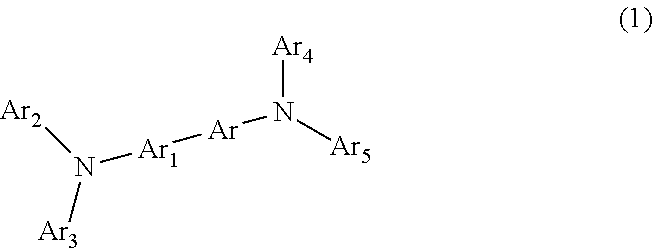Asymmetrical Aryl Amine Derivative for Organic Electroluminescence Devices, Method for Preparing Same, Organic Thin Film for Organic Electroluminescence Devices and Organic Electroluminescence Device Using Same
- Summary
- Abstract
- Description
- Claims
- Application Information
AI Technical Summary
Benefits of technology
Problems solved by technology
Method used
Image
Examples
synthesis example 1
Synthesis of Compound of Formula 22
[0070]The overall synthesis process is shown in the reaction scheme 4.
[0071]First, 5.00 g (15.0 mmol) of 6-bromo-1-iodo-naphthalene, 4.33 g (12.8 mmol) of 4-(naphthalene-2-yl-phenyl-amino)-phenylboronic acid and a catalytic amount of tetrakis(triphenylphosphine)-palladium were placed into a 250 mL-3-neck flask under a nitrogen atmosphere, 60 mL of 1,2-dimethoxy ethane and 30 mL of 2M-sodium carbonate aqueous solution were added thereto, followed by refluxing at 95° C. for 18 hours. After the reaction was completed, the reaction mixture was cooled to the room temperature, and a formed organic layer was extracted using distilled water and ethylacetate, dried with magnesium sulfate to then remove a solvent under reduced pressure. The resultant product was reprecipitated using tetrahydrofuran and methanol for filtration, followed by vacuum drying, and 8.18 g of the target compound [4-(6-bromo-naphthalene-2-yl)-phenyl]-naphthalene-2-yl-phenyl-amine repr...
synthesis example 2
Synthesis of Compound of Formula 23
[0073]The overall synthesis process is shown in the reaction scheme 5. As represented by the reaction scheme 5, the same procedure as in Synthesis Example 1 was conducted, except that [4-(6-bromo-naphthalene-2-yl)-phenyl]-naphthalene-1-yl-naphthalene-2-yl-amine represented by the formula 76 was synthesized using naphthalene-2-yl-naphthalene-1-yl-phenylboronic acid, instead of naphthalene-2-yl-phenyl-amine in the Suzuki-coupling reaction in Synthesis Example 1, and naphthalene-2-yl-phenyl amine, instead of naphthalene-2-yl-naphthalene-1-yl-amine of Synthesis Example 1, was used in an arylamination reaction. The target compound, 6-[(4-(naphthalene-2-yl-naphthalene-1-amino)-phenyl]-naphthalene-2-yl-naphthalene-2-yl-phenyl-amine, represented by the formula 23 was obtained, as confirmed by MS (EI) calcd for C52H36N2, 688.86; Found: 688.
synthesis example 3
Synthesis of Compound of Formula 24
[0074]The overall synthesis process is shown in the reaction scheme 6. As represented by the reaction scheme 6, the same procedure as in Synthesis Example 2 was conducted, except that naphthalene-1-yl-phenyl amine was used for an arylamination reaction, instead of naphthalene-2-yl-naphthalene-1-yl-amine in Synthesis Example 2. The target compound, 6-[(4-(naphthalene-2-yl-naphthalene-1-amino)-phenyl]-naphthalene-2-yl-naphthalene-1-yl-phenyl-amine, represented by the formula 24 was obtained, as confirmed by MS (EI) calcd for C52H36N2, 688.86. Found: 688.
PUM
| Property | Measurement | Unit |
|---|---|---|
| Structure | aaaaa | aaaaa |
| Efficiency | aaaaa | aaaaa |
Abstract
Description
Claims
Application Information
 Login to View More
Login to View More - R&D
- Intellectual Property
- Life Sciences
- Materials
- Tech Scout
- Unparalleled Data Quality
- Higher Quality Content
- 60% Fewer Hallucinations
Browse by: Latest US Patents, China's latest patents, Technical Efficacy Thesaurus, Application Domain, Technology Topic, Popular Technical Reports.
© 2025 PatSnap. All rights reserved.Legal|Privacy policy|Modern Slavery Act Transparency Statement|Sitemap|About US| Contact US: help@patsnap.com



